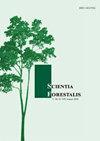Responses of African mahogany seedlings to temperature, vapor pressure deficit and water availability
IF 0.4
4区 农林科学
Q4 FORESTRY
引用次数: 0
Abstract
The genus Khaya holds significant value in the national and international forest market due to its noble wood. However, the limited understanding of species-climate interactions hinders its expansion in Brazil. To address this, we investigated the effects of different microclimates on the growth of Khaya ivorensis , Khaya senegalensis , and Khaya anthotheca seedlings, considering variations in mean air temperature (T), vapor pressure deficit (VPD), and water availability. Seedlings were cultivated in controlled environments representing three microclimates (I: 24.7 °C, 0.30 kPa VPD; II: 28.6 °C, 0.95 kPa VPD; III: 29.8 °C, 1.80 kPa VPD) with varying water availability levels (20%, 40%, 60%, and 90% of maximum water holding capacity). Growth variables were assessed. Our findings indicate that water restriction reduced seedling growth across all microclimates, leading to lower total dry mass production. Specifically, K. ivorensis exhibited robust growth under microclimates with higher water availability. K. senegalensis displayed optimal initial growth in microclimate III (29.8 °C, 1.80 KPa), particularly when subjected to higher water availability levels in the substrate.非洲红木幼苗对温度、蒸汽压亏缺和水分有效性的响应
由于其高贵的木材,Khaya属在国内和国际森林市场上具有重要的价值。然而,对物种-气候相互作用的有限理解阻碍了其在巴西的扩张。为了解决这个问题,我们研究了不同小气候对Khaya ivorensis、Khaya senegalensis和Khaya anthotheca幼苗生长的影响,考虑了平均气温(T)、蒸汽压赤字(VPD)和水分有效性的变化。幼苗在代表三种小气候的受控环境中培养(I: 24.7°C, 0.30 kPa VPD;II: 28.6°C, 0.95 kPa VPD;III: 29.8°C, 1.80 kPa VPD),不同的水可用性水平(最大持水量的20%,40%,60%和90%)。评估生长变量。研究结果表明,水分限制降低了所有小气候下的幼苗生长,导致总干产量降低。具体而言,在水分有效度较高的小气候条件下,伊沃氏桫椤表现出强劲的生长势头。塞内加尔沙蚕在小气候III(29.8°C, 1.80 KPa)条件下表现出最佳的初始生长,特别是在基质含水量较高的条件下。
本文章由计算机程序翻译,如有差异,请以英文原文为准。
求助全文
约1分钟内获得全文
求助全文
来源期刊

Scientia Forestalis
Agricultural and Biological Sciences-Forestry
CiteScore
1.00
自引率
0.00%
发文量
39
期刊介绍:
Scientia Forestalis is a scientific publication of the IPEF – Institute of Forest Research and Studies, founded in 1968, as a nonprofit institution, in agreement with the LCF – Department of Forest Sciences of the ESALQ – Luiz de Queiroz College of Agriculture of the USP – São Paulo University. Scientia Forestalis, affiliated to the ABEC – Brazilian Association of Scientific Publishers, publishes four issues per year of original papers related to the several fields of the Forest Sciences.
The Editorial Board is composed by the Editor, the Scientific Editors (evaluating the manuscript), and the Associated Editors (helping on the decision of acceptation or not of the manuscript, analyzed by the Peer-Reviewers.
 求助内容:
求助内容: 应助结果提醒方式:
应助结果提醒方式:


